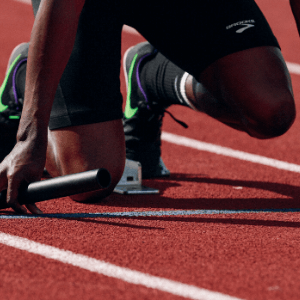 Fitness would appear to be a very effortless subject. But as more and more people regard the importance of health and fitness, this subject on “does running build muscle?”would put on a more serious tone. For example, athletes and gym goers often go to their colleagues or research online to find answers to their own fitness and health queries. While this method could offer a minimal advantage, it is earnestly believed that it can often leads to unscientific and uninformed advice. Unluckily this could end up to be disastrous or have irreparable repercussions. For instance, many fitness and gym enthusiasts believe that running or doing low impact cardio exercises can burn and reduce their muscle mass.
Fitness would appear to be a very effortless subject. But as more and more people regard the importance of health and fitness, this subject on “does running build muscle?”would put on a more serious tone. For example, athletes and gym goers often go to their colleagues or research online to find answers to their own fitness and health queries. While this method could offer a minimal advantage, it is earnestly believed that it can often leads to unscientific and uninformed advice. Unluckily this could end up to be disastrous or have irreparable repercussions. For instance, many fitness and gym enthusiasts believe that running or doing low impact cardio exercises can burn and reduce their muscle mass.
The myth: It is believed that when an athlete performs low or slow burn cardio exercises like distance running, the body will burn muscle as fuel. Persons who give faith to this myth are quick to identify as proof the stereotype bodies of distance runners. Thin, with minimal muscle mass and fat.
The fact: Contrary to the common myth, what causes the body to burn its own muscle is not performing low or slow burn cardio exercise. Instead it is most likely that these muscle loss is caused by starvation or unobserved and uninhabited undercutting of protein intake. Malnutrition often causes a meltdown of muscle mass in the body and not low impact cardio exercises. In fact studies have significantly shown that doing low impact cardio exercises actually help athletes build important muscles of the body.
1. How DOES the Body Burn its Muscle?
 We have to understand that in a normal regular physiological process the body burns fat prior to burning protein. This is because fat is broken down easily and faster. So if your body is burning muscles instead of fats, then something should not be working properly here. When this happens do not be quick to put on non-definitive solutions or ill-advised conclusions. Know the facts.
We have to understand that in a normal regular physiological process the body burns fat prior to burning protein. This is because fat is broken down easily and faster. So if your body is burning muscles instead of fats, then something should not be working properly here. When this happens do not be quick to put on non-definitive solutions or ill-advised conclusions. Know the facts.
The reason that the body is using its own muscle to fuel energy expenditures is not because of any low impact exercise. Rather it is because there is not enough protein in the body to fuel it. This may be because the person is eating less or not eating at all. Many athletes are unaware that they need to closely monitor and adapt to the protein needs of their body as it changes. The sign and symptoms of the body’s deficiency of proteins is unmistakable: brittle hair, water retention, exhaustion and constant hunger. So when an athlete becomes aware of these signs, then the solution is not to limit low impact cardio exercises but instead to increase his or her protein intake.
Of course, there are a few medical conditions that may also exhibit these symptoms. But again the fact is that these conditions are rare. So it is better yet for the athlete to first increase his or her protein intake before entertaining a more serious case or medical issue.
2. Can a Low-Impact Cardio Burn Muscle Mass?
Many believers of the “muscle burn” myth may actually be surprised to know that low impact cardio exercises have many wonderful benefits and none of them include melting your muscle mass. Scientific studies have concluded that in fact slow cardio exercises such as distance running actually help build muscle in the body. It has also been found out to help alleviate post-workout soreness, improved fitness and fast recovery during workouts or exercise. It’s about time to ditch this myth and trust science for a change.
3. Reduce Post-Workout Soreness
During low impact cardio exercises, there is an increased flow of blood to the muscles. This increased blood flow during low impact cardio workouts, pumps oxygen into the muscle giving it fresh energy which helps incredibly lessen the body’s post-workout soreness. This is highly beneficial for a sustained and less stressful fitness program.
4. Boosted Fitness Readiness
Fitness Readiness is the ability of our body to recover quickly from any exercise or workout. Poor fitness readiness could make an athlete or gym goer easily fatigued or sometimes leads to injury and inability to achieve his or her fitness goals. An athlete whose training only involves one kind of exercise routine is not too promising to develop fitness readiness. But when fitness readiness is boosted and well improved, an athlete can easily adopt any fitness exercise and training. They also often avoid work out related injuries and are able to build well rounded muscles.
5. Quick Recovery
 When the body is brought to limits and intense usage, the Central Nervous System (CNS) coordinates to regain energy to allow quick recovery to the athletes so they are on their feet again in no time. However, when doing high impact workout or exercise the CNS experiences fatigue and this could lead to the body also feeling fatigued. A low impact cardio exercise on the other hand proves to be more efficient and successful in helping an athlete attain his or her fitness goals. The CNS is enabled to some kind of “reset” the body to quickly recover from cardio exercises and give it endurance and energy to continue on its next routines. It’s not a question of how fast and impacted a workout can be. Rather we are talking here of efficiency and efficacy to hit our fitness goals with the least stress and fatigue and quick recovery to the body.
When the body is brought to limits and intense usage, the Central Nervous System (CNS) coordinates to regain energy to allow quick recovery to the athletes so they are on their feet again in no time. However, when doing high impact workout or exercise the CNS experiences fatigue and this could lead to the body also feeling fatigued. A low impact cardio exercise on the other hand proves to be more efficient and successful in helping an athlete attain his or her fitness goals. The CNS is enabled to some kind of “reset” the body to quickly recover from cardio exercises and give it endurance and energy to continue on its next routines. It’s not a question of how fast and impacted a workout can be. Rather we are talking here of efficiency and efficacy to hit our fitness goals with the least stress and fatigue and quick recovery to the body.
6. Helps Build Muscles
This is the primary benefit of a low impact cardio workout or exercise. And this settles the myth that low impact cardio burn muscle. This myth just has to rest. It’s not true.
7. Boosted Fast-Twitch Muscle Cells
Cardio exercises actually boosts up the body’s fast-twitch cell’s aerobic capacity. The fast-twitch cells are responsible for giving our muscles the natural power and strength to do explosive or high impact motions like weight lifting and high jumps. The aerobic capacity of a cell translates to how much oxygen it can use. This oxygen is converted into energy. Therefore, when a cell consumes much oxygen, then it would mean that more energy is generated. Scientists have discovered that endurance cardio exercise can absolutely generate higher aerobic capacity in the cells which means it is consuming much oxygen in the process. Although with this discovery, much is still being done to find the duration of cardio activity and its intensity needed for optimum results.
8. Spikes in the Growth Hormone
Corollary to the “muscle burn” myth is also the myth that high impact training is the sole technique to naturally cause a spike in the growth hormone (GH) level. This hormone is an important element in building our body’s muscle. Because of this false concept, athletes are made to believe that unless they do weight lifting they might as well give up all hope of bulging up those muscles.
A research conducted by the US Army found that GH levels spiked up following an intense workout and weight training. However as quickly as it spiked up it also went down immediately after the training ended. On the other hand, with endurance cardio exercises, there was noted a similar spike in the GH levels but this lasted only for approximately an hour after the workout ended. Obviously with these kinds of muscle building techniques, the muscles are overly worked without being able to sustain or deliver the results intended.
9. So Why Are Runners Thin ?
Why are most runners thin? Is it because running has burned their muscles out? Of course not! Runners are slender because of a slight imbalance in their workout techniques. Most of them opt to go more for cardio exercise rather than weight lifting. Even though running proves to be helpful in building muscle, an athlete has to incorporate cardio workout with weight lifting in order to gain results. This is important because runners mostly focus on working their legs out when they reach the gym. Weight lifting should be effectively incorporated into their workout routines. In fact, many trainers and coaches are increasingly pushing their athletes to workout also in the weight room.
10. The Value of Intensity
When an athlete is incorporating running into a workout routine, there should be placed careful considerations on the intensity of the workout rather than concerns of muscle loss. Because if intensity is too high or too low, results become farfetched. What happens is that in the end, they land anywhere in the middle. When doing a high intensity workout the athlete can lose sight of the time that’s taking their runs which in the end reduces their intensity. On the other hand, those doing too low intensity workout may also end up increasing their pace because they could not feel the body burn.
What could be the solution to this middle ground delima. Athletes may opt to have a personal trainer or workout companion to keep an objective count of the level of intensity in their workout. This way they can concentrate on their correct pace and better achieve their workout goals. Or if working out alone, an athlete can maintain the intensity of their workout by breathing low through the nose. Also switching cardio routines is also found to be very effective.
11. Still Apprehensive?
If you’re still worried about changing your cardio techniques during workouts fearing it might affect your muscles, try these safety measures to help you. An excellent pre-workout supplement called BCAA (Branch Chain Amino Acids) is known to effectively prevent the breaking down of stored protein in the body and instead directs it to burn the available stored fat. Athletes can safely incorporate the BCAA to their protein shakes at least 15-30 minutes before working out. This way you get the assurance that muscle mass remains unaffected during workout.
Recommended Post For You
